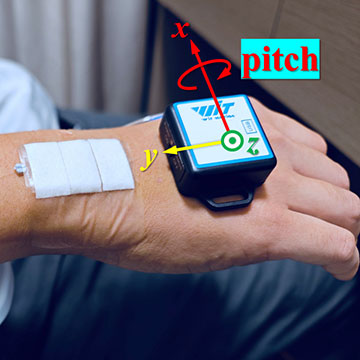
A wearable sensor exploits a fiber Bragg grating to monitor hand gestures and movements of the mouth [Image: Kun Xiao, Beijing Normal University]
Researchers in China have created a wearable sensor that they say accurately detects small movements of the body, including hand gestures and facial expressions (Biomed. Opt. Express, doi: 10.1364/BOE.517104). Designed to be comfortable for long-term wear, the flexible sensor could be used to monitor the progress of patients who are recovering from strokes and to provide a practical communication mechanism for people with speech and mobility impairments.
This work is part of a larger project aimed at developing innovative assistive technologies to improve the quality of life for post-stroke patients, as well as continuous monitoring methods to support their recovery. “Our goal was to develop a wearable solution that was both precise in detecting gestures and comfortable for everyday use, offering a more personalized and adaptive approach to rehabilitation and assistance,” said Zhuo Wang from Beijing Normal University.
Integrating FBGs
The new sensor is made from a soft and flexible material called PDMS, a silicone elastomer that is comfortable to wear on the skin. Embedded in the PDMS is a fiber Bragg grating (FBG), which is formed by etching a periodic pattern in a short section of silica fiber. The resulting variation in refractive index causes an FBG to reflect specific wavelengths while transmitting all others, with the wavelength of the reflected light changing in response to key parameters for biomechanical monitoring, including strain, pressure and torque.
A sensor attached to the wrist was shown to provide accurate and repeatable measurements of the joint's up-and-down rotation.
Experiments by the researchers showed that embedding the FBGs into thicker layers of the elastomer generated a more pronounced wavelength shift, improving the sensitivity of the optical sensors to smaller movements. A precise calibration method was also developed to tailor the response to the specific part of the body and to the physical mobility of each user.
Wearable patch
Working with a small number of volunteers, the researchers tested the capabilities of the device for recognizing different hand gestures and facial movements. After the calibration process, a sensor attached to the wrist was shown to provide accurate and repeatable measurements of the joint's up-and-down rotation. The wearable patch could also detect subtle movements of the finger and the mouth, which the researchers exploited to translate simple gestures into messages spelled out in Morse code.
The team is now working to make the technology ready for practical use, which will require a more portable and cost-effective system for acquiring and analyzing the sensor data. They also hope to enhance the system's ability to communicate wirelessly with smartphones, computers and medical devices, and to improve the robustness of the sensors to withstand daily wear and tear.
